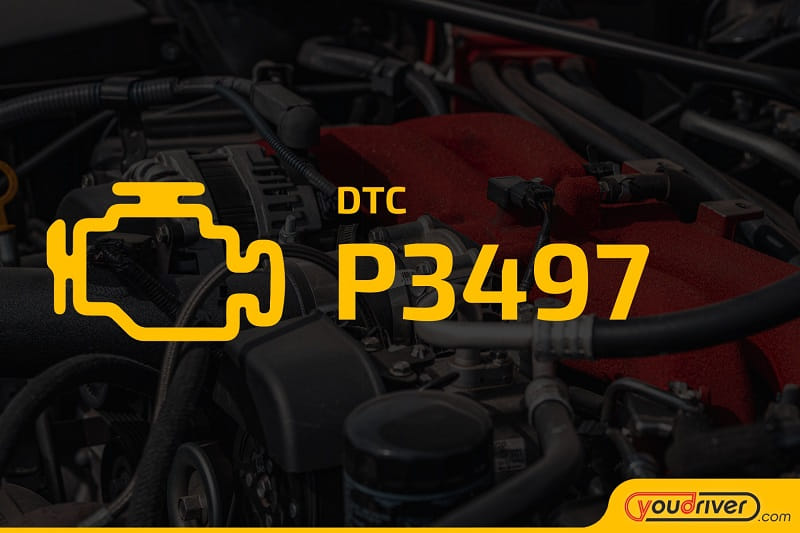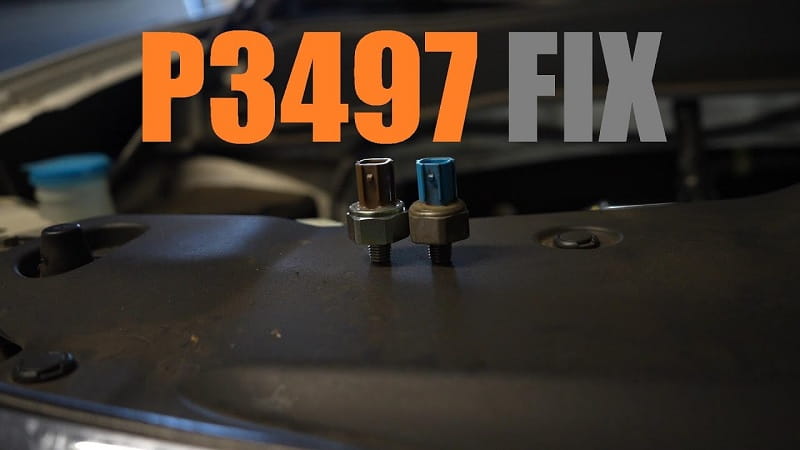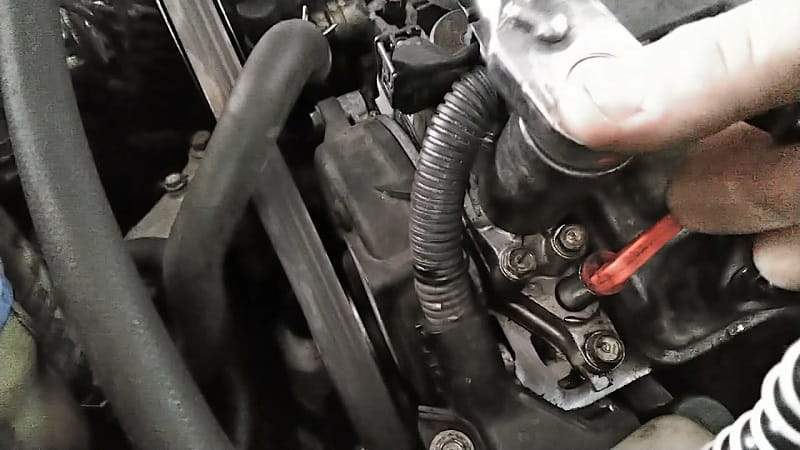This post contains affiliate links. This means I will make a commission at no extra cost to you should you click through and make a purchase [ “As an Amazon Associate, I earn from qualifying purchases.” ]. Read the full disclosure here.
P3497 Cylinder Deactivation System Bank 2 GuideMechanic.Com As automotive technology evolves, manufacturers continually develop innovative systems to improve fuel economy, reduce emissions, and enhance overall engine performance.
One such advancement is cylinder deactivation, a system that temporarily disables certain cylinders when full engine power is not needed.
However, as with any complex system, faults can occur that trigger diagnostic trouble codes (DTCs). One of these is P3497: Cylinder Deactivation System Bank 2.
This article offers an in-depth explanation of the P3497 code, including its causes, symptoms, diagnostic procedures, repair solutions, and preventive maintenance recommendations.
See Also: P3492 Cylinder 12 Deactivation/Intake Valve Control Circuit High
P3497 Cylinder Deactivation System Bank 2
What Is Cylinder Deactivation?
Cylinder deactivation (also known as Active Fuel Management (AFM), Displacement on Demand (DoD), or Variable Cylinder Management (VCM), depending on the manufacturer) allows an engine to temporarily shut off certain cylinders during low-load conditions such as cruising or idling.
This helps improve fuel economy and reduce exhaust emissions without compromising performance when full power is needed.
The system relies on several integrated components, including:
- Engine Control Module (ECM)
- Intake and exhaust valve control solenoids
- Hydraulic lifters
- Oil pressure control valves
- Oil passages and galleries
- Electrical wiring and connectors
- Engine sensors (such as oil pressure, temperature, and camshaft position sensors)
When operating correctly, cylinder deactivation is seamless and unnoticeable to the driver.
What Does P3497 Mean?

The P3497 diagnostic trouble code indicates that the Engine Control Module (ECM) has detected a malfunction in the cylinder deactivation system on Bank 2.
Let’s break it down:
- P3497: The OBD-II fault code assigned to this specific problem.
- Cylinder Deactivation System: The system responsible for temporarily disabling some cylinders.
- Bank 2: Refers to the side of the engine containing the even-numbered cylinders (typically cylinders 2, 4, 6, and 8 on a V-engine configuration).
When this code is triggered, it means the ECM has detected that the deactivation system on Bank 2 is not functioning properly — either the cylinders are not deactivating when they should, or they are not reactivating when required.
P3497 Cylinder Deactivation System Bank 2
How Does the Cylinder Deactivation System Work?
The cylinder deactivation system operates by:
- Monitoring driving conditions through sensors (speed, throttle position, load, temperature, etc.).
- When low-load conditions are detected, the ECM sends signals to the solenoids controlling the intake and exhaust valve operation.
- These solenoids activate special hydraulic lifters that hold the valves closed, effectively disabling combustion in selected cylinders.
- Once higher power demand returns, the system reactivates the cylinders by disengaging the lifters and resuming normal valve operation.
- Precise coordination of electrical signals, oil pressure, and hydraulic mechanisms is crucial for smooth operation. Any failure in these systems can trigger DTCs like P3497.
Causes of P3497
The P3497 code may result from several potential issues, usually divided into electrical, hydraulic, mechanical, or control system categories:
Electrical Causes
- Faulty valve control solenoids on Bank 2
- Damaged or shorted wiring harnesses
- Corroded or loose electrical connectors
- Malfunctioning Engine Control Module (ECM)
Hydraulic Causes
- Low engine oil level
- Incorrect oil viscosity
- Contaminated oil (sludge or debris clogging oil passages)
- Oil pressure control valve failure
Mechanical Causes
- Sticking or malfunctioning hydraulic lifters on Bank 2
- Worn or damaged valve train components (rocker arms, camshaft, springs)
Sensor-Related Causes
- Faulty oil pressure sensor
- Malfunctioning camshaft position sensor
Software and Calibration Issues
- Outdated ECM software
- Incorrect calibration or programming errors
P3497 Cylinder Deactivation System Bank 2
Symptoms of P3497
The symptoms of a P3497 code may range from subtle to severe, depending on the extent of the failure:
- Illuminated Check Engine Light (CEL)
- Rough idle or engine vibrations
- Loss of power during acceleration
- Reduced fuel efficiency
- Increased exhaust emissions
- Engine hesitation or misfire
- Abnormal engine noises (tapping, ticking)
- Limp mode activation (in severe cases)
In some cases, the driver may not notice any obvious drivability issues beyond the illuminated check engine light.
Diagnosing P3497

Accurate diagnosis is critical to identify the root cause of the P3497 code. A systematic approach helps avoid unnecessary repairs and expenses:
1. Retrieve Trouble Codes
- Use a professional-grade OBD-II scanner to confirm the presence of P3497.
- Check for any accompanying codes related to oil pressure, valve control circuits, or sensor malfunctions.
2. Visual Inspection
- Inspect the wiring harnesses on Bank 2 for damage, fraying, or loose connections.
- Examine the valve control solenoid connectors for corrosion or poor contact.
3. Oil Inspection
- Check the engine oil level, quality, and viscosity.
- Dirty or degraded oil can significantly affect the hydraulic lifters and solenoids.
4. Solenoid Testing
- Test the valve control solenoids on Bank 2 using a digital multimeter to check resistance.
- Use a scan tool with bi-directional control to activate the solenoids and verify their function.
5. Oil Pressure Testing
- Perform an oil pressure test to verify adequate oil supply to the hydraulic lifters.
6. Mechanical Inspection
- Inspect hydraulic lifters and valve train components for sticking, wear, or mechanical damage.
7. Sensor Evaluation
- Test oil pressure and camshaft position sensors for proper operation.
8. ECM Evaluation
- Verify ECM software version and check for available updates or technical service bulletins (TSBs).
P3497 Cylinder Deactivation System Bank 2
Repair Options for P3497
The correct repair solution depends on the root cause identified during diagnosis:
Electrical Repairs
- Replace defective valve control solenoids on Bank 2.
- Repair or replace damaged wiring harnesses.
- Clean or replace corroded connectors.
- Replace ECM (if determined to be faulty).
Hydraulic Repairs
- Change engine oil using the manufacturer-specified viscosity.
- Flush oil passages to remove sludge or debris.
- Replace a faulty oil pressure control valve.
Mechanical Repairs
- Replace malfunctioning hydraulic lifters on Bank 2.
- Repair or replace worn rocker arms, camshafts, or valve springs.
Sensor Repairs
- Replace faulty oil pressure or camshaft position sensors.
Software Updates
- Update the ECM with the latest manufacturer-released software.
Estimated Repair Costs
Repair Type Estimated Cost
- Oil Change and Flush $100 – $250
- Solenoid Replacement $200 – $600
- Wiring Repairs $150 – $400
- Hydraulic Lifter Replacement $1000 – $3500
- ECM Replacement $500 – $1500
- Sensor Replacement $150 – $400
Note: Actual costs may vary depending on vehicle make, model, labor rates, and parts availability.
Preventive Maintenance for P3497

While not all issues can be prevented, many potential failures can be minimized through proper maintenance:
- Adhere to manufacturer-recommended oil change intervals.
- Use the correct oil type and viscosity.
- Inspect wiring and connectors regularly for damage or corrosion.
- Address minor engine performance issues promptly.
- Install ECM software updates as recommended by the manufacturer.
- Use high-quality parts to prevent premature failures.
Conclusion
The P3497: Cylinder Deactivation System Bank 2 code indicates a malfunction within the cylinder deactivation system for the second bank of the engine.
Given the complexity of cylinder deactivation systems, multiple components can contribute to this fault — including electrical circuits, hydraulic mechanisms, sensors, and even software issues.
Timely and accurate diagnosis is essential to pinpoint the cause and prevent further damage. With proper maintenance and quick attention to any warning signs, drivers can ensure that their engine’s cylinder deactivation system continues functioning efficiently and reliably.
- Small Dump Trucks for Sale - August 13, 2025
- Used Dump Truck for Sale by Owner - August 13, 2025
- Used Isuzu Dump Truck for Sale - August 13, 2025
